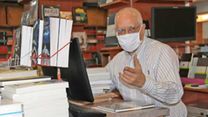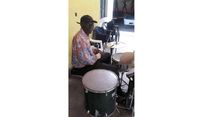Tribute to master sculptor who immortalised history

Faces are stubborn. Reproducing them through painting or carving requires paying great attention to detail. Get one feature wrong and the end product will look completely different from the subject.
Artist Oshottoe Ondula, who died aged 59 two weeks ago, discovered early in life the secrets of reproducing a person’s face and body with striking accuracy, when he began his career in art by painting portraits and later moved to making sculptures.
With pin-point precision, aided by measurements and research, he would ensure the subject’s features resembled those of the real subject, and that is the skill that helped him beat tens of competitors to win the tender to construct the Tom Mboya statue in Nairobi.
Oshottoe once said in an interview that even Mr Mboya’s family nodded in approval when they saw the model he had made in the bidding stages of the project.
“The sculpturing came so naturally,” his cousin Keziah says. “There is nothing he sculpted that did not look like what he was trying to make.”
His son Mandela Ondula, who has ventured into art by learning the ropes from his father, is in agreement.
“He was a tough artist, an art genius. I can’t put his greatness into words,” says Mandela, who has so far made a number of sculptures for the Catholic Church.
By the time of his death, he had made numerous sculptures, including one for founding President Jomo Kenyatta currently at a square in Cuba dedicated to African leaders who pursued liberation from colonialists.
In 2018, he also worked on a sculpture of Tanzania’s first President Julius Nyerere, which had been commissioned by the Tanzanian government, which was also taken to the Cuba heroes’ square.
He died at a time when he had completed a bronze statue of freedom fighter Ronald Ngala that is yet to be allocated a site for its erection. Mr Ngala’s family, including former Kanu politician Noah Katana Ngala, had given consent for the final product.
SCULPTING LIONS
He had also mastered the art of sculpting lions, and his models of the king of the jungle are in different locations in Kenya, including the Jomo Kenyatta mausoleum in Nairobi. His lion sculptures were also placed in two roundabouts along Nairobi’s Uhuru Highway and outside City Hall through city beautification efforts by embattled Nairobi Governor Mike Sonko.
The mausoleums of Jaramogi Oginga Odinga, Tom Mboya and Kijana Wamalwa also incorporate his works. At the Supreme Court buildings in Nairobi, the sculpture of a naked boy holding a fish in a fountain of waters is also a product of his hands.
Oshottoe also made sculptures that Kenya gifted visiting dignitaries. In 1983, he made an eagle sculpture that President Daniel arap Moi presented to Queen Elizabeth II.
He said last year that that was the first project he was commissioned to do as an artist. His efforts saw him receive a Head of State Commendation by Mr Moi that year.
His works were also gifted to former Indian Prime Minister Indira Ghandi (1981), former Canadian Prime Minister Pierre Trudeau (1981), and South Africa’s founding President Nelson Mandela (1994).
Oshottoe also made a sculpture of Barack Obama Sr which was presented to his son, former US president Barack Obama, by his grandmother in 2015.
His death in a fire at his house in Nairobi’s Donholm is currently under investigation. Not much is known of the cause of the fire in his ground floor house where he was living by himself. Amid the Covid-19 pandemic, the widowed father of four had retreated to the house and was mostly working in solitude.
FOUND DEAD
According to Mandela, the fire only consumed the living room and left the rest of the house intact. He was found dead behind the couch. An autopsy conducted at the Chiromo Mortuary on Tuesday revealed that his body had sustained 40 per cent burns and that his death resulted from carbon monoxide poisoning through inhalation of smoke.
Neighbours on the first floor said they noticed that their floor was feeling unusually warm for some time that night. They, however, did not make much of it. The next morning, a neighbour noticed smoke was coming from Oshottoe’s house. That is when they alerted the caretaker and the authorities were called in.
His son remembers speaking to him a day before his death. He had informed Mandela that he had ordered some clay to keep himself busy by moulding clay figurines. These figurines are what he would use as a reference when working on his larger projects.
His death leaves a big gap in Kenya’s art scene, given his great skill and desire to preserve history. Mandela remembers working on Tom Mboya’s statue with his father. It was during the first semester break of his first year as he pursued a diploma in fine arts at Kenyatta University.
Oshottoe gave his son the task of painting the flamingos and doing the rock art for the project. On the day the monument was launched by the then President Mwai Kibaki, he was right next to Mr Kibaki and his vice president, Kalonzo Musyoka. He also got to dine with the family of Tom Mboya later that day at Crowne Plaza.
“My father had always told me that he had met the president in his twenties and now I could say the same thing,” says Mandela, proudly.
Mandela laments that although the Tom Mboya statue was unveiled in 2011, his father wasn’t issued with the completion certificate until the period of commissioning had lapsed. By the time of his death, he was complaining that he only got the deposit to start the work and the retention fee while doing the monument. But the balance, which has been accruing interest since 2011, is yet to be paid.
At a personal level, the burly Oshottoe was different things to different people, and one of his outstanding traits was reclusiveness.
“He was a man of very few words but when you got to know him, he was someone with the biggest heart that I’ve ever known,” says his cousin Keziah, currently living in Ireland.
Keziah lived with Oshottoe for some time before relocating abroad, and she witnessed the creation of some of his works, some which she says are on display in a number of buildings in Nairobi.
IMPOSING PHYSIQUE
She adds that despite his imposing physique, he was a gentle, peaceful man.
“He was a very gentle soul; somebody who never picked fights, who never quarrelled. He was very peaceful, as far as I am concerned. Not even one day did I see him quarrel with anybody during the time I lived with him,” she says, adding that he was sometimes enigmatic and so not many people understood him.
Mandela remembers, bemusedly, how people would be shocked to find out his father was an artist, given his size and height.
Easily over six-feet- four- inches tall, he would have seemed better cut for brawn-intensive fields like security rather than being a master of precision and delicateness that his works required.
“When you got to know him, that’s when you saw that he was a gentle giant. We used to see him doing the sculpting. My sister and I would compete in moulding animal and plant figurines from clay, in order to see who would do it best, because we wanted to emulate him. He later on helped me better my craft by insisting that everything I did, had to come from calculating and taking measures,” remembers Mr Mandela.
Oshottoe also insisted on referring to books and not just going by what “felt right”.
“Mzee was a living icon,” says Mr Mandela. “He was a mentor who happened to be my father. He’s a very unique person who left a mark on all who met him.”
The shadow of his father looms so large that even Mandela’s works have been assumed to be his father’s. Mr Ondula would brag that he was the only artist to have his name on a sculpture in Nairobi’s central business district.
His artistic instinct to push boundaries did not always bode well with the audience. For instance in 2014, he worked on a sculpture commissioned by Sikh faithful in Kisumu that went awfully wrong.
SIKH TEMPLE
The Sikhs, who were celebrating 100 years of their presence in the lakeside town, spent around Sh3 million to have Mr Ondula create a 2.5-metre high statue that depicted a woman praying.
It was to be erected at the roundabout at the intersection of Nyerere Road and Paul Mboya Road, a short distance from a Sikh temple in the lakeside town.
But because it bordered on the abstract, a section of locals protested against the figure, with some claiming it symbolised idol worship. Protesters defaced it and it was pulled down by cranes days after being unveiled. Oshottoe later restored it but kept it in his workshop.
“It is a simple image of a woman praying and has nothing to do with anyone’s religion,” Oshottoe would later say.
“This art form is not new. If one buys the Tabaka soapstone sculptures (that greatly resemble the rejected figure) will one be said to be worshipping an idol?” he posed.
In March 2019, he was also in an eye of a storm after a set of lions he created for City Hall drew criticism for their un-lion-like looks.
But he would later clarify that those were unfinished works. Days later, more conventional lion sculptures took the place of the initial figures.
Born in Siaya County in July 1960, the artist born to Luke Ondula was left-handed and that is how “Oshottoe” and “Left” became his monikers.














Post a Comment